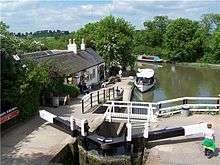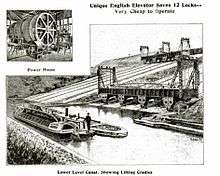Foxton Locks
| Foxton Locks and Inclined Plane | |
|---|---|
|
Upper staircase of Foxton Locks | |
| Location | Leicestershire, UK |
| Coordinates | 52°29′59″N 0°58′59″W / 52.4998°N 0.9830°WCoordinates: 52°29′59″N 0°58′59″W / 52.4998°N 0.9830°W |
| Built | 1814 and 1900 |
| Architect | Benjamin Bevan (Canal & Locks), Gordon Cale Thomas (Inclined Plane) |
| Governing body | British Waterways (The Canal & River Trust from summer 2012)[1] |
Listed Building – Grade II* | |
| Official name: Foxton Locks, Grand Union Canal Leicester line | |
| Designated | 7 December 1966[2] |
| Reference no. | 1360753 |
Listed Building – Grade II | |
| Official name: Lock-Keeper's Cottage adjacent to Foxton Top Lock | |
| Designated | 9 March 1989[3] |
| Reference no. | 1360774 |
Listed Building – Grade II | |
| Official name: Lock-Keeper's Cottage with adjoining stable block and Foxton Canal Craft Shop, adjacent to Foxton Bottom Lock, Grand Union Canal | |
| Designated | 9 March 1989[4] |
| Reference no. | 1061459 |
| Official name: Inclined Plane immediately east of Foxton Locks | |
| Designated | 24 January 1973[5] |
| Reference no. | 1018832 |
 Location of Foxton Locks and Inclined Plane in Leicestershire | |
Foxton Locks (grid reference SP691895) are ten canal locks consisting of two "staircases" each of five locks, located on the Leicester line of the Grand Union Canal about 5 km west of the Leicestershire town of Market Harborough and are named after the nearby village of Foxton.
They form the northern terminus of a 20-mile summit level that passes Husbands Bosworth, Crick and ends with the Watford flight
Staircase locks are used where a canal needs to climb a steep hill, and consist of a group of locks where each lock opens directly into the next, that is, where the bottom gates of one lock form the top gates of the next. Foxton Locks are the largest flight of such staircase locks on the English canal system.
The Grade II* listed locks are a popular tourist attraction and the county council has created a country park at the top. At the bottom, where the junction with the arm to Market Harborough is located, there are two public houses, a shop, trip boat and other facilities. The area is popular with gongoozlers.
Alongside the locks is the site of the Foxton Inclined Plane, an inclined plane built in 1900 as a solution to various operational restrictions imposed by the lock flight. It was not a commercial success and remained in full-time operation for only ten years. It was dismantled in 1926, but a project to re-create the Plane commenced in the 2000s, since the locks remain a bottleneck for boat traffic.
The locks

Building work on the locks started in 1810 and took four years.[6] Little changed until the building of the inclined plane resulted in the reduction in size of some of the side pounds.[6] While the inclined plane was in operation the locks were allowed to fall into decline to an extent and in 1908 the committee released £1,000 to bring the locks back into full (nightly) operation.[7][8]
In 2008, the locks became part of the European Route of Industrial Heritage, a network which seeks to recognize the most important industrial heritage sites in Europe.[9]
The locks are usually manned during the cruising season from Easter to October and padlocked outside operating hours. This is done to prevent water shortages due to misuse and to ensure a balance between those wishing to ascend and descend. There can be lengthy delays at busy times but the actual transit should take approximately 45 minutes to one hour to complete; it is made quicker by the fact that the locks are narrow beam and the gates are light.
Foxton Inclined Plane
By 1897, the Grand Junction Canal Company had acquired several of the canals comprising the Leicester line, and was keen to meet demand from carriers seeking to use wider beam (14 ft) craft, rather than the traditional narrow beam boats, which were the only type the locks could accommodate. Their solution was to build an inclined plane to the side of the locks. Initially, the company had planned for the plane to replace the locks, rather than having it act as a second, faster option. Construction began in 1898 and was finished by 10 July 1900.[8]
The Plane was designed by Gordon Cale Thomas, after a large-scale prototype was built at the company's Bulbourne yard and he had assessed the 75 ft climb.[8] It had two tanks, or caissons, each capable of holding two narrowboats or a barge. The caissons were full of water, and so balanced each other. The caissons' vertical guillotine gates created a watertight seal.[8] The lift was powered by a 25-horsepower (19 kW) stationary steam engine. The land for the Plane was purchased for £1,595 and total expenses for the project came to £39,244 by 24 June 1900.[10]

The inclined plane had a journey time of 12 minutes for two boats up and two down, compared with 1¼ hours through the old lock system,[8] thereby improving the speed of passage up the hill tremendously. During a 12-hour day, 6,000 tons (6,100 tonnes) of cargo could pass through the upper and lower level.[8] Unlike the locks, where water flowed downhill every time a boat passed through, on the inclined plane almost the same amount of water went up and down the hill. Only the displaced water is moved, thus saving a great deal of water and giving better control of this vital resource.
An initial problem with the plane was the stress on the tracks by the caissons.[8] There was a plan to build a similar inclined plane at the Watford Locks at the southern end of the canal's summit level. However, this was never carried through (perhaps due to the low levels of traffic in the plane's first two years),[8] and as the Watford Locks were never widened, the economic benefits of the plane could not be fully realised. The need to continually maintain a supply of steam for the plane's engine – in expectation of traffic – also proved to be a drain on finances.[8] Thus, despite its obvious effectiveness, the Foxton Inclined Plane was mothballed in 1911 to save money. After that date it saw occasional use when the locks were undergoing maintenance.[11]
In 1926, dismantling of the incline's machinery began, and it was sold for scrap in 1928 for a mere £250.[8] That year the chimney on the engine house was demolished and its bricks used for various canal repairs.[12]
The plane today
The remains of the plane can still be seen, and the site explored by visitors (to a limited extent).
The mooring bollards from the incline can be found alongside the locks.[12]
Foxton Canal Museum
The Foxton Canal Museum is located in the former boiler house for the plane's steam engine. The museum covers the history of the locks and the plane, the lives of the canal workers, and other aspects of the local canal. There is also a collection of Measham pottery.
The museum opened in 1989 and is accredited by the Museums, Libraries and Archives Council.[13]
Restoration
The site of the Foxton Inclined Plane Boat Lift has been recognised as a Scheduled Ancient Monument[5] and was on the Monuments at Risk Register.[14] This recognition, together with the steady increase in leisure boating on British canals, means its restoration is now considered a key project in the development of the national waterway network.
The cost of full restoration has been estimated at £9 million (2006 figures), and is to be tackled in a series of stages.
Stage 1 of the project – the clearing of the site and restoration of the canal arms above and below the plane – was completed in 2008. A grant for £1.7 million was received from the Heritage Lottery Fund towards the £2.8 million cost of this first stage, and its successful completion resulted in the site being removed from the Monuments at Risk register.[15][16]
See also
- Bingley Five Rise Locks in West Yorkshire
- Bingley Three Rise Locks in West Yorkshire
- Foxton Inclined Plane Trust
- Watford Locks in Northamptonshire
- Caen Hill Locks near Devizes, Wiltshire
- Fourteen Locks near Newport, South Wales
- Tardebigge Locks near Bromsgrove, Worcestershire
References
- Uhlemann, H-J., (2002), Canal Lifts and Inclines of the World, Internat Limited, ISBN 0-9543181-1-0
- ↑ "British Waterways Press release". 4 April 2012. Retrieved 19 April 2012.
- ↑ Historic England. "Foxton Locks (1360753)". National Heritage List for England. Retrieved 19 April 2012.
- ↑ Historic England. "Top Lock cottage (1360774)". National Heritage List for England. Retrieved 19 April 2012.
- ↑ Historic England. "Bottom Lock cottage (1061459)". National Heritage List for England. Retrieved 19 April 2012.
- 1 2 Historic England. "Inclined Plane (1018832)". National Heritage List for England. Retrieved 19 April 2012.
- 1 2 Foxton Locks and Inclined Plane A Detailed History. Department of Planning and Transportation, Leicestershire County Council. p. 3. ISBN 0-85022-191-9.
- ↑ Foxton Locks and Inclined Plane A Detailed History. Department of Planning and Transportation, Leicestershire County Council. p. 35. ISBN 0-85022-191-9.
- 1 2 3 4 5 6 7 8 9 10 Hugh McKnight (1987). The Shell Book of Inland Waterways. David & Charles. pp. 46–49. ISBN 0-7153-8239-X.
- ↑ "Foxton Locks achieves European recognition". Waterscape. 2008-11-25. Retrieved 2009-08-09.
- ↑ Foxton Locks and Inclined Plane A Detailed History. Department of Planning and Transportation, Leicestershire County Council. p. 9. ISBN 0-85022-191-9.
- ↑ Foxton Locks and Inclined Plane A Detailed History. Department of Planning and Transportation, Leicestershire County Council. p. 36. ISBN 0-85022-191-9.
- 1 2 Foxton Locks and Inclined Plane A Detailed History. Department of Planning and Transportation, Leicestershire County Council. p. 37. ISBN 0-85022-191-9.
- ↑ http://www.fipt.org.uk/Museum.html
- ↑ "Monument no longer at risk".
- ↑ Foxton Inclined Plane Trust: The Lift
- ↑ "Heritage At Risk (East Midlands) – Report 2008" (PDF).
Further reading
- "Canal Boats with Loads Elevated 75ft". Popular Mechanics. 7 (10): 1010–1011. October 1905.
External links
| Wikimedia Commons has media related to Foxton Inclined Plane and Lock Staircase. |
- Foxton Locks and Partnership
- Foxton Inclined Plane Trust
- Foxton Canal Museum
- Historic England. "Locks - Grade II* (191334)". Images of England.
- Heritage at Risk: Foxton
